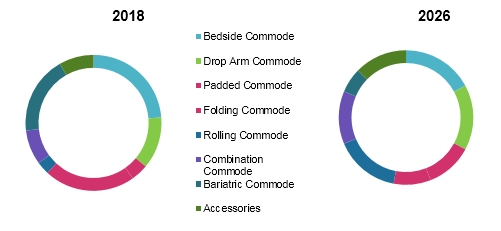Medical commode are used by people or patients who were recently undergone surgery procedures, physically challenged, bedridden, and disabled. Furthermore, commodes are used when it is difficult to travel to the toilet or for support over the toilet. Commodes may come with or without wheels. Medical commode are mostly designed to be cleaned easily and enhance patient usability, patient experience, and comfort. Depending on this factors, medical commodes include bedside commode, bariatric commodes, rolling commodes, and folding commodes. Most of the bedside commodes are designed to look similar to chair, but function as a toilet.
Bedside commodes are usually placed next to the bed for the convenience of people who are unable to briskly walk to the bathroom. They come in a variety of styles, colors, and models. They are portable and can accompany to different rooms. Increased functionality of medical commode help to drive its adoption in the emerging market.
The global medical commode market size was valued at US$ 582.8 Mn in 2017, and is expected to witness a CAGR of 3.8% during the forecast period (2018 – 2026).
Global Medical Commode Market Share, By Product Type: 2018 & 2026

To learn more about this report, Request sample copy
Source: Coherent Market Insights Analysis
Increasing Number of Physically Challenged Population is expected to Fuel the Adoption of Medical Commode during the Forecast Period
Medical commode used by physically challenged people or patient are mostly designed for easy shifting and moving physically challenged people from one place to another with the help of attendee or by means of self-propelling. Moreover, wheel chair design was developed as a combined solution in a basic wheel chair model with commode design for ease of defecation for the patients and elder people.
Furthermore, increasing number of physically challenged population worldwide is expected to propel the adoption of medical commode during the forecast period. For instance, according to World Health Organization (WHO): 2019; around 15% of the world's population lives with some form of disability, of whom 2-4% experience significant difficulties in functioning. Furthermore, according to the American Community Survey (ACS), an annual survey conducted by the US Census Bureau, the overall percentage of people with disabilities in the US in 2016, was 12.8%.
Global Medical Commode Market Share (%), By Material: 2018 & 2026

To learn more about this report, Request sample copy
Source: Coherent Market Insights Analysis
Increasing Number of Bariatric Surgery, Worldwide is expected to Aid in Market Growth
Increasing number of people opting for bariatric surgery, worldwide is expected to propel the adoption of medical commode in near future. For instance, according to the American Society for Metabolic and Bariatric Surgery (ASMBS): June 2018; an estimated 228,000 bariatric surgeries were performed in the U.S. during 2017. Moreover, patient’s healthcare costs for patients suffering from morbid obesity are reduced by 29% within five years following bariatric surgery, which is related to a decrease or full elimination of comorbidities associated with obesity. This factor leads to the incased bariatric surgery procedures, worldwide.
Individuals with morbid obesity or BMI≥30 have a 50-100% increased risk of premature death as compared to individuals of healthy weigh. Moreover, increasing inclination of obese population towards bariatric surgery is expected to drive growth of bariatric commode segment in medical commode market, in near future. According to World Health Organization (WHO): February 2018 data findings, in 2016, more than 1.9 billion adults, 18 years and older, were overweight. Of these over 650 million were obese. Furthermore, around 39% of adults aged 18 years and over were overweight in 2016, and 13% were obese.
Patients spend an average of two to five days in the hospital following bariatric surgery, or longer if complications develop. Patients who undergo laparoscopic bariatric surgery usually have a shorter hospital stay. Moreover, during the hospital stay and during the home recovery, heathcare professionals recommends patient to use medical commode for personal hygiene.
The two most important considerations when purchasing a bariatric commode are the dimensions and weight limit. Patients weighing more than 500 pounds should consider a bariatric commode such as the Drive Medical Deluxe Bariatric Commode, which can support weight up to 650 pounds. Furthermore, to offer the most of comfort and convenience to patient, key players in the market are offering mobile bariatric commodes. Design advancement in this commodes enables chair to be used also as a shower chair or over the toilet.
Key players operating in the medical commode market include Medline Industries, Inc., Cardinal Health, Inc., McKesson Medical-Surgical Inc., Drive Medical, Invacare Corporation, NOVA Medical Products, Cascade Healthcare Solutions, MEYRA GmbH, Avacare medical, and Lagooni B.V.
Share
Share
Missing comfort of reading report in your local language? Find your preferred language :
Transform your Strategy with Exclusive Trending Reports :
Frequently Asked Questions
Select a License Type
Credibility and Certifications

860519526

9001:2015
27001:2022


Joining thousands of companies around the world committed to making the Excellent Business Solutions.
View All Our Clients
US Reciprocal Tax Impact Analysis On Medical Commode Market
Stay updated on tariff changes with expert insights and timely information